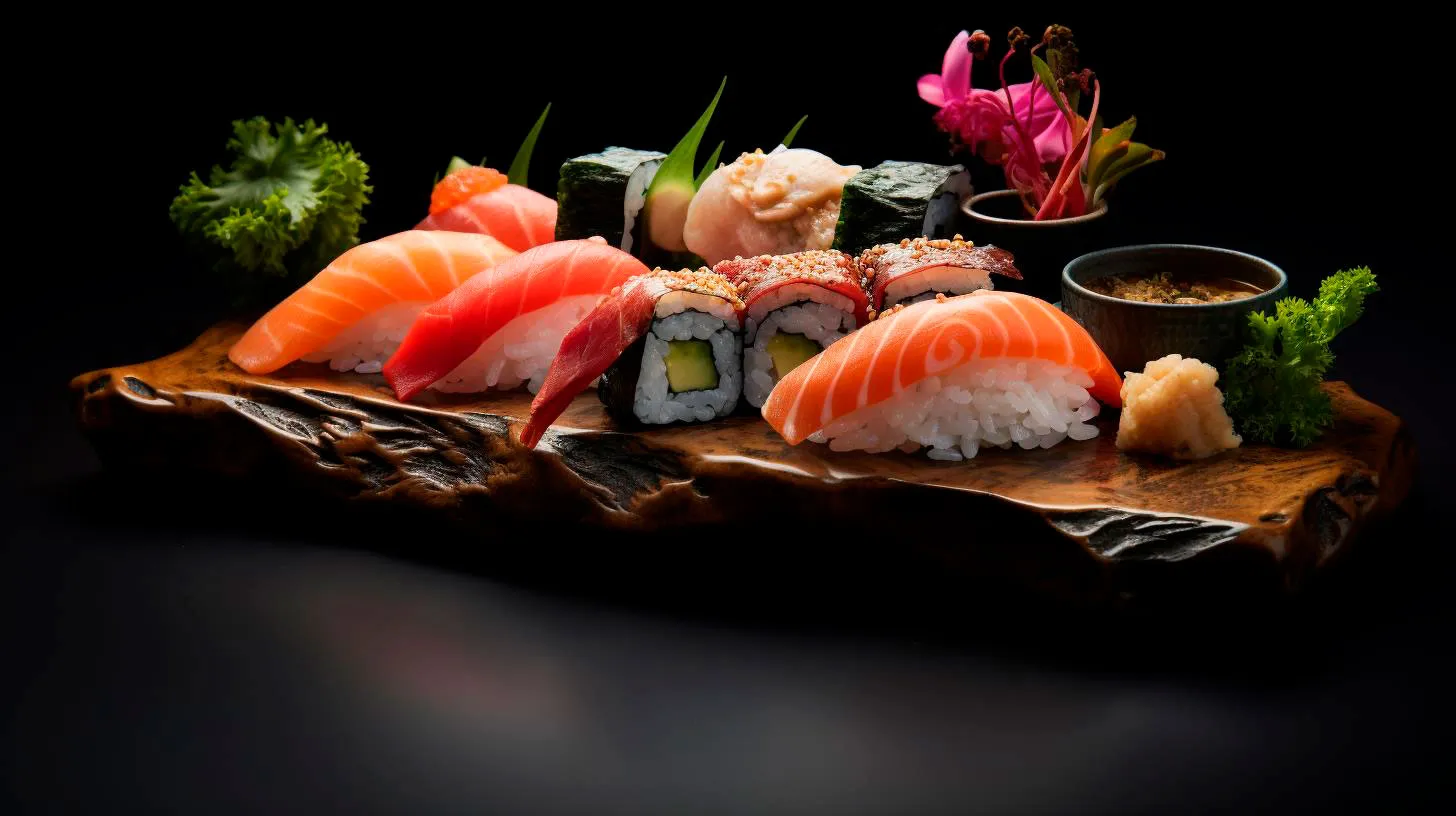Choosing the Right Rice for Perfect Sushi at Home
While there are many types of rice available, not all are created equal when it comes to sushi preparation. In this article, we will dive into the world of sushi rice and explore the essential factors to consider when selecting the perfect rice for making sushi at home.
The Significance of Sushi Rice
Sushi rice, also known as shari, is the foundation of any sushi dish. Its texture and stickiness are essential to hold together all the ingredients and create the characteristic bite-sized rolls we all love. Sushi rice should have a sticky and slightly chewy texture while maintaining its shape. Additionally, the rice should be able to absorb the flavors of the other ingredients used in sushi, such as vinegar, soy sauce, and fresh fish, while still enhancing their overall taste.
Characteristics of Ideal Sushi Rice
Here are some key characteristics to consider when selecting the ideal rice for sushi:
- Short-Grain: Sushi rice should be short-grained to ensure a cohesive texture that holds together when rolled.
- Sticky: Sticky rice is necessary to create firm and well-formed sushi rolls without falling apart.
- Pearlescent Appearance: The grains of sushi rice should have a pearlescent sheen, indicating that the rice has been properly polished.
- Proper Starch Composition: Sushi rice should have a high amylopectin content, which contributes to its stickiness.
Types of Rice Suitable for Sushi
While there are several rice varieties available, not all are suitable for making sushi. Here are some top choices:
- Koshihikari Rice: Widely regarded as the best rice for sushi, Koshihikari is a premium short-grain rice known for its excellent texture and flavor.
- Calrose Rice: Calrose rice, a medium-grain rice, is another popular choice for sushi-making due to its sticky and slightly sweet nature.
- Sasanishiki Rice: Sasanishiki rice, a variety from Japan, is known for its natural sweetness and superior stickiness, making it an ideal option for sushi.
Essential Tips for Preparing Sushi Rice
Once you’ve selected the right rice, here are a few tips to ensure it turns out perfectly:
- Proper Washing: Rinse the rice thoroughly under cold water until the water runs clear to remove excess starch.
- Correct Water-to-Rice Ratio: Use the appropriate water-to-rice ratio, usually 1:1.1, to achieve the desired consistency and texture.
- Time for Soaking: Allow the rice to soak in water for around 30 minutes before cooking to improve its stickiness.
- Perfect Cooking Technique: Cook the rice in a rice cooker or on the stovetop, following the specific instructions for the chosen rice variety.
- Vinegar Seasoning: After cooking, mix the rice with seasoned rice vinegar for that signature sushi flavor.
Conclusion
Choosing the right rice is essential for creating perfect sushi at home. The ideal sushi rice should be short-grained, sticky, and able to absorb the flavors of other ingredients. Opting for renowned rice varieties like Koshihikari, Calrose, or Sasanishiki will significantly contribute to the overall taste and texture of your sushi rolls. By following the proper preparation techniques, washing, soaking, and cooking the rice correctly, you can elevate your homemade sushi to a whole new level. So, the next time you crave sushi, remember that the secret lies in choosing the perfect rice!
Key takeaways:
- Choosing the right rice is crucial for making perfect sushi at home.
- The ideal sushi rice should be short-grained, sticky, and have a pearlescent sheen.
- Koshihikari, Calrose, and Sasanishiki are popular rice varieties for sushi.
- Proper washing, soaking, and cooking techniques are vital for sushi rice preparation.
- Using seasoned rice vinegar adds the distinctive sushi flavor.
Remember, mastering the art of sushi making takes practice, but with the right rice, you’re already well on your way to creating sushi that rivals your favorite sushi restaurant.
Mastering the Art of Washing Sushi Rice for the Perfect Texture
In this article, we will delve into the art of washing sushi rice to help you achieve that perfectly sticky and flavorful result.
Why is Washing Sushi Rice Important?
Washing sushi rice goes beyond mere cleanliness. It plays a vital role in enhancing the flavor and texture of the rice. Here’s why this step is so crucial:
- Removal of surface starch: Sushi rice contains a significant amount of starch on its surface, which can lead to a gummy texture. By washing the rice, you eliminate this excess starch and prevent the grains from clumping together.
- Better absorption: Washing rice helps improve its ability to absorb water. This allows the grains to cook more evenly and achieve a fluffy texture.
- Removing impurities: Washing rice helps get rid of any impurities or contaminants that might affect its taste or texture.
The Step-by-Step Guide to Washing Sushi Rice
Now that we understand the importance of washing sushi rice, let’s dive into the step-by-step process. Follow these instructions to achieve the perfect texture every time:
Step 1: Measure the Rice
Start by measuring the desired amount of sushi rice using a measuring cup. It is recommended to use short-grain Japanese rice for sushi, as it has the necessary stickiness and texture.
Step 2: Rinse the Rice
Place the measured rice into a large bowl or strainer. Fill it with cold water and gently swirl the rice with your hand, allowing the water to circulate around the grains. As you do this, you will notice the water becoming cloudy. This is the starch being released from the rice.
Step 3: Repeat the Process
Drain the cloudy water and repeat the rinsing process two to three more times until the water appears clearer. This ensures that most of the surface starch is removed.
Step 4: Soak the Rice
Once the rice is thoroughly rinsed, transfer it to a clean bowl and cover it with fresh water. Allow the rice to soak for about 30 minutes. This step helps the grains absorb water more evenly during cooking.
Step 5: Drain the Rice
After soaking, drain the water from the rice using a fine-mesh strainer. It is vital to remove as much water as possible to maintain the correct rice-to-water ratio while cooking.
Step 6: Cook the Rice
Now that your rice is properly washed and drained, you can proceed with cooking it according to your preferred method, be it in a rice cooker or on the stovetop.
Key Takeaways:
To summarize, here are the key takeaways to remember when washing sushi rice:
- Washing sushi rice removes excess starch, resulting in a better texture.
- Rinsing rice improves its water absorption, leading to more evenly cooked grains.
- Washing rice removes impurities that may affect its taste.
Remember, mastering the art of washing sushi rice is essential for achieving that perfect texture, which is the hallmark of excellent sushi. By following these steps, you’ll be well on your way to creating homemade sushi that rivals even the best sushi restaurants.
Pro Tips for Achieving the Ideal Sushi Rice Consistency at Home
Why is the Rice Consistency Important?
Sushi rice is not your typical boiled rice; it’s a delicate balance of flavor, moisture, and stickiness. The consistency of the rice greatly affects the texture and taste of the final sushi roll. If the rice is too hard or undercooked, the sushi rolls become difficult to chew and lack flavor. On the other hand, if the rice is too soft or overcooked, it can become mushy and ruin the overall sushi experience.
Pro Tips for Perfect Sushi Rice
Here are some expert tips to help you achieve the perfect sushi rice consistency:
1. Choose the Right Rice
The type of rice you choose for sushi is crucial. It’s recommended to use short-grain Japanese rice, such as Calrose or sushi rice. These varieties are stickier and have a higher starch content, which gives sushi rice its signature texture.
2. Rinse the Rice
Rinsing the rice before cooking is important to remove excess starch, which can make the rice sticky or clumpy. Place the rice in a fine-mesh sieve and rinse under cold water until the water runs clear. This step helps ensure the rice cooks evenly and results in a fluffier texture.
3. Follow the Right Water-to-Rice Ratio
Measuring the water-to-rice ratio correctly is essential for perfectly cooked sushi rice. Use a 1:1 ratio, which means for every cup of rice, add an equal amount of water. This ratio may vary slightly depending on the type of rice, so be sure to check the specific instructions on the package.
4. Cook the Rice Properly
When cooking sushi rice, it’s best to use a rice cooker to ensure consistent results. If you don’t have a rice cooker, use a heavy-bottomed pot with a tight-fitting lid. Once the rice is cooked, allow it to sit in the pot or cooker for an additional 10-15 minutes to allow the steam to distribute evenly.
5. Season with Rice Vinegar Mixture
After the rice is cooked, transfer it to a large, shallow bowl, and gently fluff it with a spatula or rice paddle. While the rice is still warm, drizzle in a mixture of rice vinegar, sugar, and salt and gently fold the rice to evenly distribute the seasoning. Be careful not to mash the rice grains, as this will affect the texture.
Key Takeaways
- Choose short-grain Japanese rice for the best sushi rice consistency.
- Rinse the rice before cooking to remove excess starch.
- Use a 1:1 water-to-rice ratio for perfectly cooked sushi rice.
- Cook the rice in a rice cooker or heavy-bottomed pot with a tight-fitting lid.
- Allow the cooked rice to sit for 10-15 minutes before seasoning.
By following these pro tips, you’ll be well on your way to achieving the ideal sushi rice consistency at home. With practice and experimentation, you’ll master the art of sushi rice and elevate your homemade sushi to a whole new level!
Unlocking the Secrets of Seasoning Sushi Rice for Authentic Flavors
The Importance of Properly Seasoned Sushi Rice
Sushi rice is more than just a bland filler. It serves as the foundation upon which all other sushi ingredients are built. Properly seasoned sushi rice not only adds a subtle yet essential flavor but also provides the ideal texture that complements the fresh fish, vegetables, and various toppings that top your sushi rolls. By getting the seasoning right, you can create sushi that is bursting with authentic flavors, just like the ones you would find in Japan.
The Key Ingredients for Seasoning Sushi Rice
1. Rice Vinegar: Rice vinegar is the most vital ingredient for seasoning sushi rice. It not only provides acidity but also helps prevent the rice from turning sticky. The ideal vinegar-to-rice ratio is about 10% of the total cooked rice weight.
2. Sugar: Adding sugar helps balance the acidity of the rice vinegar and enhances the overall taste of the sushi rice. The recommended amount of sugar is around 2-3% of the weight of the cooked rice.
3. Salt: Salt helps bring out the flavors in the rice and other sushi ingredients. Adding a small amount of salt, about 1% of the cooked rice weight, is essential to achieving a well-rounded taste.
The Art of Seasoning Sushi Rice
1. Cook the Rice: Start by washing the sushi rice to remove excess starch. Cook the rice with the appropriate amount of water, following the instructions on the packaging. Once cooked, let it sit for a while to cool down slightly.
2. Prepare the Sushi Vinegar: In a small saucepan, heat the rice vinegar, sugar, and salt on low heat until the sugar and salt dissolve completely. Make sure not to bring it to a boil. Alternatively, you can warm the vinegar in the microwave for a few seconds.
3. Season the Rice: Transfer the cooked rice to a large, flat container. Gradually pour the sushi vinegar over the rice while gently folding it in using a wooden spatula. This ensures that each grain is evenly coated without crushing them. Continue folding until the rice absorbs the vinegar and becomes glossy.
Key Takeaways for Perfectly Seasoned Sushi Rice
- Use rice vinegar to add acidity and prevent stickiness.
- Add sugar to balance the acidity and enhance the overall taste.
- Incorporate a small amount of salt to bring out the flavors.
- Wash the sushi rice before cooking to remove starch.
- Gradually fold the sushi vinegar into the rice to ensure even coating.
With these secrets of seasoning sushi rice, you can be confident in creating an authentic sushi experience in the comfort of your own home. Remember that practice makes perfect, so don’t be afraid to experiment and adjust the seasoning to suit your personal taste preferences. Mastering the art of sushi rice will undoubtedly elevate your sushi-making skills and impress your family and friends. Enjoy the delightful flavors of perfectly seasoned sushi rice!



